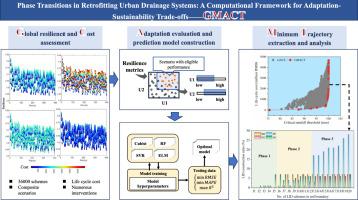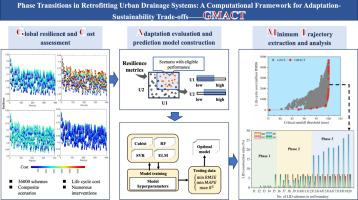城市排水系统改造中的相变:适应性与可持续性权衡的计算框架
IF 12.4
1区 环境科学与生态学
Q1 ENGINEERING, ENVIRONMENTAL
引用次数: 0
摘要
气候变化迫使各国大力投资改造城市排水系统(UDSs)。然而,有限的信息可能导致资源分配效率低下,从而加剧了冗余-效率的困境。传统的多目标优化等决策方法受到静态情景的约束,缺乏适应多种适应路径的灵活性,无法捕捉到适应过程的非线性演化。本研究旨在通过开发基于物理和数据驱动的混合计算框架,建立适应与可持续性之间动态和非线性关系的全球视角。以海绵城市低影响开发(LID)为例,揭示了全球最小适应成本轨迹(GMACT)清晰地揭示了适应转型模式。早期的LID干预措施提高了24%的适应性,增加了10%的生命周期成本(LCC),而后期的措施显示出收益递减,需要提高90%的LCC,而只增加了2%。分析揭示了一种分叉模式,即帕累托最优解分散在GMACT之上,低于成本转折点,从而允许多种可行的适应途径。在这一点之外,解决方案向GMACT靠拢,这表明实现高适应性需要与此轨迹保持一致。研究结果强化了gact作为适应规划的战略参考,为UDS决策者提供了强大的决策支持工具,指导在深度不确定性下具有成本效益和可持续的UDS升级。本文章由计算机程序翻译,如有差异,请以英文原文为准。


Phase transitions in retrofitting urban drainage systems: a computational framework for adaptation-sustainability trade-offs
Climate change is compelling nations to invest heavily in retrofitting urban drainage systems (UDSs). However, limited information can lead to inefficient resource allocation, exacerbating the redundancy-efficiency dilemma. Traditional decision-making methods, such as multi-objective optimization, fail to capture the nonlinear evolution of adaptation, as they are constrained by static scenarios and lack the flexibility to accommodate multiple adaptation pathways. This study aims to establish a global perspective on the dynamic and nonlinear relationship between adaptation and sustainability by developing a hybrid, physics-based and data-driven computational framework. The Global Minimum Adaptation Cost Trajectory (GMACT) distinctly reveals adaptation transition patterns, demonstrated through a case study on Low Impact Development (LID) in Sponge City. Early-stage LID interventions improved adaptability by 24 % with a 10 % increase in life-cycle cost (LCC), while late-stage measures showed diminishing returns, requiring a 90 % LCC rise for just a 2 % gain. The analysis uncovered a bifurcation pattern, where Pareto-optimal solutions disperse above GMACT below a cost turning point, allowing multiple viable adaptation pathways. Beyond this point, solutions converge toward GMACT, suggesting that achieving high adaptability necessitates alignment with this trajectory. Findings reinforce GMACT as a strategic reference for adaptation planning, providing UDSs policymakers with a robust decision-support tool for guiding cost-effective and sustainable UDS upgrades under deep uncertainty.
求助全文
通过发布文献求助,成功后即可免费获取论文全文。
去求助
来源期刊

Water Research
环境科学-工程:环境
CiteScore
20.80
自引率
9.40%
发文量
1307
审稿时长
38 days
期刊介绍:
Water Research, along with its open access companion journal Water Research X, serves as a platform for publishing original research papers covering various aspects of the science and technology related to the anthropogenic water cycle, water quality, and its management worldwide. The audience targeted by the journal comprises biologists, chemical engineers, chemists, civil engineers, environmental engineers, limnologists, and microbiologists. The scope of the journal include:
•Treatment processes for water and wastewaters (municipal, agricultural, industrial, and on-site treatment), including resource recovery and residuals management;
•Urban hydrology including sewer systems, stormwater management, and green infrastructure;
•Drinking water treatment and distribution;
•Potable and non-potable water reuse;
•Sanitation, public health, and risk assessment;
•Anaerobic digestion, solid and hazardous waste management, including source characterization and the effects and control of leachates and gaseous emissions;
•Contaminants (chemical, microbial, anthropogenic particles such as nanoparticles or microplastics) and related water quality sensing, monitoring, fate, and assessment;
•Anthropogenic impacts on inland, tidal, coastal and urban waters, focusing on surface and ground waters, and point and non-point sources of pollution;
•Environmental restoration, linked to surface water, groundwater and groundwater remediation;
•Analysis of the interfaces between sediments and water, and between water and atmosphere, focusing specifically on anthropogenic impacts;
•Mathematical modelling, systems analysis, machine learning, and beneficial use of big data related to the anthropogenic water cycle;
•Socio-economic, policy, and regulations studies.
 求助内容:
求助内容: 应助结果提醒方式:
应助结果提醒方式:


